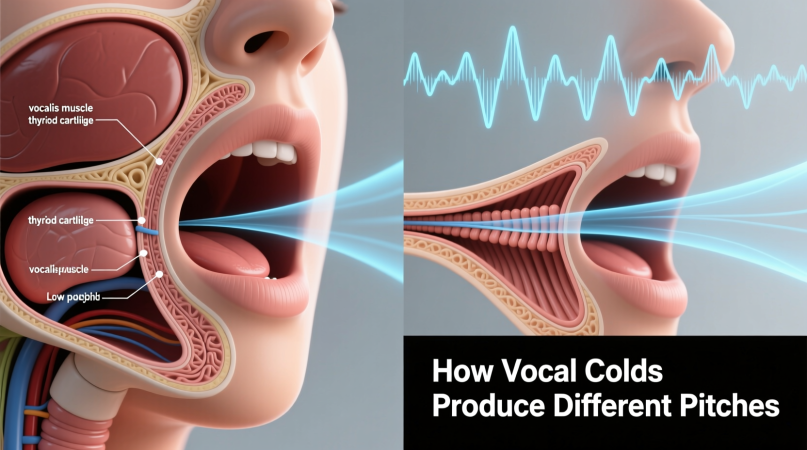
If you’ve ever wondered why your voice can shift from deep, low notes to light, high ones, the answer lies in how your vocal cords (vocal folds) work. These small muscles in your larynx are like the strings of an instrument—stretching, tightening, and vibrating to create different sounds.
Here’s a simple breakdown of how vocal cords produce pitch and what it means for singers.
The Basics: Vocal Cords as Vibrating Instruments
- Location: Inside the larynx (voice box).
- Function: They vibrate as air passes from the lungs, creating sound.
- Pitch Control: Depends on length, tension, and thickness of the cords.
👉 Think of them like guitar strings:
- Tight + thin = higher pitch.
- Loose + thick = lower pitch.
How Tension and Length Change Pitch
- High Notes
- Vocal cords stretch and thin out.
- Muscles called the cricothyroid pull them tighter.
- Vibrations become faster → higher pitch.
- Low Notes
- Vocal cords relax and thicken.
- The thyroarytenoid muscle shortens them.
- Vibrations slow down → lower pitch.
📌 Quick fact: A man’s vocal cords usually vibrate around 100–150 times per second (Hz), while a woman’s can vibrate 200–250+ times per second on average.
The Role of Air Pressure and Breath Support
Pitch stability isn’t only about cord tension—it also depends on airflow.
- Steady airflow = clear, steady pitch.
- Too much pressure = strain or cracking.
This is why singers are taught to use diaphragmatic breathing—it supports the vocal cords without overloading them.
Resonance: Why the Same Pitch Sounds Different
Even if two singers hit the same pitch, their voices sound unique. Why?
- The sound resonates through the throat, mouth, and nasal cavities.
- Shaping vowels and adjusting space changes the tone color, not the actual pitch.
Registers: Chest, Head, and Mix
Different registers reflect how vocal cords vibrate:
- Chest voice: Cords are thicker, vibrations feel strong and low.
- Head voice: Cords stretch thinner, producing lighter, higher notes.
- Mixed voice: A blend that smooths the transition.
👉 Learning to control these shifts helps singers avoid cracks in their range.
Quick Table: What Affects Vocal Pitch
| Factor | High Pitch | Low Pitch |
|---|---|---|
| Length | Longer, stretched | Shorter, relaxed |
| Thickness | Thinner | Thicker |
| Tension | Increased | Decreased |
| Vibration Hz | Faster (~250+ per second) | Slower (~100 per second) |
Why This Matters for Singers
Understanding how vocal cords work helps you:
- Expand your vocal range safely.
- Avoid pushing or straining when singing high or low.
- Train more effectively by focusing on breath, posture, and resonance.
👉 Try testing your natural range with the free Vocal Range Calculator to see how your cords are working across pitches.
FAQs
How do vocal cords actually vibrate?
Air from the lungs sets them into motion. They open and close rapidly, producing sound waves.
Which muscles control vocal pitch?
The cricothyroid (for higher pitches) and the thyroarytenoid (for lower pitches).
Are vocal cords like guitar strings?
Yes, both work on the principle of tension and vibration speed.
Why does my voice crack?
Cracks happen when cords shift suddenly between registers without smooth coordination.
